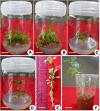Differential Gene Expression and Withanolides Biosynthesis During in vitro and ex vitro Growth of Withania somnifera (L.) Dunal
- PMID: 35774803
- PMCID: PMC9237602
- DOI: 10.3389/fpls.2022.917770
Differential Gene Expression and Withanolides Biosynthesis During in vitro and ex vitro Growth of Withania somnifera (L.) Dunal
Abstract
Ashwagandha (Withania somnifera L. Dunal) is a medicinally important plant with withanolides as its major bioactive compounds, abundant in the roots and leaves. We examined the influence of plant growth regulators (PGRs) on direct organogenesis, adventitious root development, withanolide biosynthetic pathway gene expression, withanolide contents, and metabolites during vegetative and reproductive growth phases under in vitro and ex vitro conditions. The highest shooting responses were observed with 6-benzylaminopurine (BAP) (2.0 mg L-1) + Kinetin (KIN) (1.5 mg L-1) supplementation. Furthermore, BAP (2.0 mg L-1) + KIN (1.5 mg L-1) + gibberellic acid (GA3) (0.5 mg L-1) exhibited better elongation responses with in vitro flowering. Half-strength MS medium with indole-3-butyric acid (IBA) (1.5 mg L-1) exhibited the highest rooting responses and IBA (1.0 mg L-1) with highest fruits, and overall biomass. Higher contents of withaferin A (WFA) [∼8.2 mg g-1 dry weight (DW)] were detected in the reproductive phase, whereas substantially lower WFA contents (∼1.10 mg g-1 DW) were detected in the vegetative phase. Cycloartenol synthase (CAS) (P = 0.0025), sterol methyltransferase (SMT) (P = 0.0059), and 1-deoxy-D-xylulose-5-phosphate reductase (DXR) (P = 0.0375) genes resulted in a significant fold change in expression during the reproductive phase. The liquid chromatography-mass spectrometry (LC-MS) analysis revealed metabolites that were common (177) and distinct in reproductive (218) and vegetative (167) phases. Adventitious roots cultured using varying concentrations of indole-3-acetic acid (IAA) (0.5 mg L-1) + IBA (1.0 mg L-1) + GA3 (0.2 mg L-1) exhibited the highest biomass, and IAA (0.5 mg L-1) + IBA (1.0 mg L-1) exhibited the highest withanolides content. Overall, our findings demonstrate the peculiarity of withanolide biosynthesis during distinct growth phases, which is relevant for the large-scale production of withanolides.
Keywords: Withania somnifera; adventitious roots; differential gene expression; ex vitro; in vitro; metabolites; organogenesis; withanolide.
Copyright © 2022 Thorat, Kaniyassery, Poojari, Rangel, Tantry, Kiran, Joshi, Rai, Botha and Muthusamy.
Conflict of interest statement
The authors declare that the research was conducted in the absence of any commercial or financial relationships that could be construed as a potential conflict of interest.
Figures









Similar articles
-
Optimization of elicitation conditions with methyl jasmonate and salicylic acid to improve the productivity of withanolides in the adventitious root culture of Withania somnifera (L.) Dunal.Appl Biochem Biotechnol. 2012 Oct;168(3):681-96. doi: 10.1007/s12010-012-9809-2. Epub 2012 Jul 28. Appl Biochem Biotechnol. 2012. PMID: 22843063
-
Carbon sources and medium pH affects the growth of Withania somnifera (L.) Dunal adventitious roots and withanolide A production.Nat Prod Res. 2013;27(2):185-9. doi: 10.1080/14786419.2012.660691. Epub 2012 Mar 7. Nat Prod Res. 2013. PMID: 22394118
-
Red laser-mediated alterations in seed germination, growth, pigments and withanolide content of Ashwagandha [Withania somnifera (L.) Dunal].J Photochem Photobiol B. 2021 Mar;216:112144. doi: 10.1016/j.jphotobiol.2021.112144. Epub 2021 Jan 29. J Photochem Photobiol B. 2021. PMID: 33556702
-
A critical assessment of the whole plant-based phytotherapeutics from Withania somnifera (L.) Dunal with respect to safety and efficacy vis-a-vis leaf or root extract-based formulation.Toxicol Mech Methods. 2023 Oct;33(8):698-706. doi: 10.1080/15376516.2023.2242933. Epub 2023 Aug 14. Toxicol Mech Methods. 2023. PMID: 37533233 Review.
-
Critical factors influencing in vitro propagation and modulation of important secondary metabolites in Withania somnifera (L.) dunal.Plant Cell Tissue Organ Cult. 2022;149(1-2):41-60. doi: 10.1007/s11240-021-02225-w. Epub 2022 Jan 12. Plant Cell Tissue Organ Cult. 2022. PMID: 35039702 Free PMC article. Review.
Cited by
-
Proteomic and Biochemical Approaches Elucidate the Role of Millimeter-Wave Irradiation in Wheat Growth under Flooding Stress.Int J Mol Sci. 2022 Sep 8;23(18):10360. doi: 10.3390/ijms231810360. Int J Mol Sci. 2022. PMID: 36142271 Free PMC article.
References
-
- Bagadekar A. N., Jayaraj M. (2011). In vitro flowering of Heliotropium indicum L. – an important medicinal herb. Asian J. Exp. Biol. Sci. 2 90–95.
-
- Betsui F., Tanaka-Nishikawa N., Shimomura K. (2004). Anthocyanin production in adventitious root cultures of Raphanus sativus L. cv. Peking Koushin. Plant Biotechnol. 21 387–391. 10.5511/plantbiotechnology - DOI
-
- Chakraborty N., Banerjee D., Ghosh M., Pradhan P., Gupta N. S., Acharya K., et al. (2013). Influence of plant growth regulators on callus mediated regeneration and secondary metabolites synthesis in Withania somnifera (L.) Dunal. Physiol. Mol. Biol. Plants 19 117–125. 10.1007/s12298-012-0146-2 - DOI - PMC - PubMed
LinkOut - more resources
Full Text Sources

